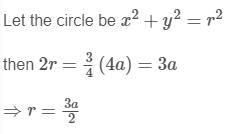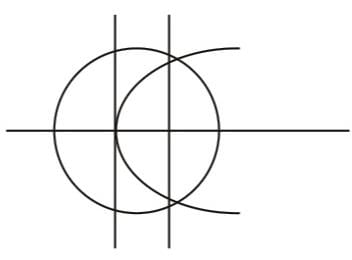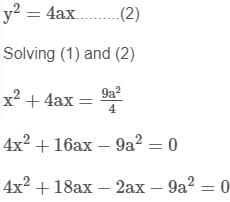JEE Exam > JEE Questions > A circle is described whose centre is the ver...
Start Learning for Free
A circle is described whose centre is the vertex and whose diameter is three-quarters of the latus rectum of a parabola y2 = 4ax. The common chord of the circle and parabola is
- a)x = a/2
- b)x = −a/2
- c)x = a/4
- d)None of these
Correct answer is option 'A'. Can you explain this answer?
Verified Answer
A circle is described whose centre is the vertex and whose diameter is...


 is the required circle ......(1)
is the required circle ......(1)now given parabola is


⇒ x = a/2 common chord of circle and parabola.
Most Upvoted Answer
A circle is described whose centre is the vertex and whose diameter is...
A/4c)x = 2a/bd)x = 4a/b
We can start by finding the equation of the circle. The diameter is three-quarters of the latus rectum, which is 4a. So the diameter of the circle is 3a. The radius of the circle is half the diameter, which is 3a/2. The center of the circle is the vertex of the parabola, which is at (0,0). So the equation of the circle is:
x^2 + y^2 = (3a/2)^2
Simplifying, we get:
x^2 + y^2 = 9a^2/4
Next, we need to find the common chord of the circle and the parabola. This is the line that intersects both the circle and the parabola. Since the center of the circle is at (0,0), the line must pass through the origin.
To find the equation of the line, we can use the fact that it intersects the parabola. Substituting y^2 = 4ax into the equation of the circle, we get:
x^2 + 4ax = 9a^2/4
Simplifying, we get:
x^2 + 4ax - 9a^2/4 = 0
This is a quadratic equation in x, and we can solve it using the quadratic formula:
x = (-4a ± sqrt(16a^2 - 4(1)(-9a^2)))/(2)
Simplifying, we get:
x = (-4a ± sqrt(64a^2))/(2)
x = -2a ± 8a/2
x = -2a ± 4a
So the two solutions are x = -6a and x = 2a.
Since the line passes through the origin, we can write the equation of the line as:
y = mx
where m is the slope. To find m, we can use the fact that the line intersects the parabola. Substituting y = mx into y^2 = 4ax, we get:
(m x)^2 = 4ax
Simplifying, we get:
x^2 m^2 = 4ax
Dividing both sides by x^2, we get:
m^2 = 4a/x
Substituting x = -6a and x = 2a, we get:
m^2 = -2 and m^2 = 8
Since m^2 cannot be negative, we can discard the first solution and take m = sqrt(8) = 2sqrt(2). So the equation of the common chord is:
y = 2sqrt(2) x
Therefore, the answer is (d) x = 4a/b.
We can start by finding the equation of the circle. The diameter is three-quarters of the latus rectum, which is 4a. So the diameter of the circle is 3a. The radius of the circle is half the diameter, which is 3a/2. The center of the circle is the vertex of the parabola, which is at (0,0). So the equation of the circle is:
x^2 + y^2 = (3a/2)^2
Simplifying, we get:
x^2 + y^2 = 9a^2/4
Next, we need to find the common chord of the circle and the parabola. This is the line that intersects both the circle and the parabola. Since the center of the circle is at (0,0), the line must pass through the origin.
To find the equation of the line, we can use the fact that it intersects the parabola. Substituting y^2 = 4ax into the equation of the circle, we get:
x^2 + 4ax = 9a^2/4
Simplifying, we get:
x^2 + 4ax - 9a^2/4 = 0
This is a quadratic equation in x, and we can solve it using the quadratic formula:
x = (-4a ± sqrt(16a^2 - 4(1)(-9a^2)))/(2)
Simplifying, we get:
x = (-4a ± sqrt(64a^2))/(2)
x = -2a ± 8a/2
x = -2a ± 4a
So the two solutions are x = -6a and x = 2a.
Since the line passes through the origin, we can write the equation of the line as:
y = mx
where m is the slope. To find m, we can use the fact that the line intersects the parabola. Substituting y = mx into y^2 = 4ax, we get:
(m x)^2 = 4ax
Simplifying, we get:
x^2 m^2 = 4ax
Dividing both sides by x^2, we get:
m^2 = 4a/x
Substituting x = -6a and x = 2a, we get:
m^2 = -2 and m^2 = 8
Since m^2 cannot be negative, we can discard the first solution and take m = sqrt(8) = 2sqrt(2). So the equation of the common chord is:
y = 2sqrt(2) x
Therefore, the answer is (d) x = 4a/b.

|
Explore Courses for JEE exam
|

|
Similar JEE Doubts
A circle is described whose centre is the vertex and whose diameter is three-quarters of the latus rectum of a parabola y2= 4ax. The common chord of the circle and parabola isa)x = a/2b)x = −a/2c)x = a/4d)None of theseCorrect answer is option 'A'. Can you explain this answer?
Question Description
A circle is described whose centre is the vertex and whose diameter is three-quarters of the latus rectum of a parabola y2= 4ax. The common chord of the circle and parabola isa)x = a/2b)x = −a/2c)x = a/4d)None of theseCorrect answer is option 'A'. Can you explain this answer? for JEE 2025 is part of JEE preparation. The Question and answers have been prepared according to the JEE exam syllabus. Information about A circle is described whose centre is the vertex and whose diameter is three-quarters of the latus rectum of a parabola y2= 4ax. The common chord of the circle and parabola isa)x = a/2b)x = −a/2c)x = a/4d)None of theseCorrect answer is option 'A'. Can you explain this answer? covers all topics & solutions for JEE 2025 Exam. Find important definitions, questions, meanings, examples, exercises and tests below for A circle is described whose centre is the vertex and whose diameter is three-quarters of the latus rectum of a parabola y2= 4ax. The common chord of the circle and parabola isa)x = a/2b)x = −a/2c)x = a/4d)None of theseCorrect answer is option 'A'. Can you explain this answer?.
A circle is described whose centre is the vertex and whose diameter is three-quarters of the latus rectum of a parabola y2= 4ax. The common chord of the circle and parabola isa)x = a/2b)x = −a/2c)x = a/4d)None of theseCorrect answer is option 'A'. Can you explain this answer? for JEE 2025 is part of JEE preparation. The Question and answers have been prepared according to the JEE exam syllabus. Information about A circle is described whose centre is the vertex and whose diameter is three-quarters of the latus rectum of a parabola y2= 4ax. The common chord of the circle and parabola isa)x = a/2b)x = −a/2c)x = a/4d)None of theseCorrect answer is option 'A'. Can you explain this answer? covers all topics & solutions for JEE 2025 Exam. Find important definitions, questions, meanings, examples, exercises and tests below for A circle is described whose centre is the vertex and whose diameter is three-quarters of the latus rectum of a parabola y2= 4ax. The common chord of the circle and parabola isa)x = a/2b)x = −a/2c)x = a/4d)None of theseCorrect answer is option 'A'. Can you explain this answer?.
Solutions for A circle is described whose centre is the vertex and whose diameter is three-quarters of the latus rectum of a parabola y2= 4ax. The common chord of the circle and parabola isa)x = a/2b)x = −a/2c)x = a/4d)None of theseCorrect answer is option 'A'. Can you explain this answer? in English & in Hindi are available as part of our courses for JEE.
Download more important topics, notes, lectures and mock test series for JEE Exam by signing up for free.
Here you can find the meaning of A circle is described whose centre is the vertex and whose diameter is three-quarters of the latus rectum of a parabola y2= 4ax. The common chord of the circle and parabola isa)x = a/2b)x = −a/2c)x = a/4d)None of theseCorrect answer is option 'A'. Can you explain this answer? defined & explained in the simplest way possible. Besides giving the explanation of
A circle is described whose centre is the vertex and whose diameter is three-quarters of the latus rectum of a parabola y2= 4ax. The common chord of the circle and parabola isa)x = a/2b)x = −a/2c)x = a/4d)None of theseCorrect answer is option 'A'. Can you explain this answer?, a detailed solution for A circle is described whose centre is the vertex and whose diameter is three-quarters of the latus rectum of a parabola y2= 4ax. The common chord of the circle and parabola isa)x = a/2b)x = −a/2c)x = a/4d)None of theseCorrect answer is option 'A'. Can you explain this answer? has been provided alongside types of A circle is described whose centre is the vertex and whose diameter is three-quarters of the latus rectum of a parabola y2= 4ax. The common chord of the circle and parabola isa)x = a/2b)x = −a/2c)x = a/4d)None of theseCorrect answer is option 'A'. Can you explain this answer? theory, EduRev gives you an
ample number of questions to practice A circle is described whose centre is the vertex and whose diameter is three-quarters of the latus rectum of a parabola y2= 4ax. The common chord of the circle and parabola isa)x = a/2b)x = −a/2c)x = a/4d)None of theseCorrect answer is option 'A'. Can you explain this answer? tests, examples and also practice JEE tests.

|
Explore Courses for JEE exam
|

|
Signup for Free!
Signup to see your scores go up within 7 days! Learn & Practice with 1000+ FREE Notes, Videos & Tests.
























